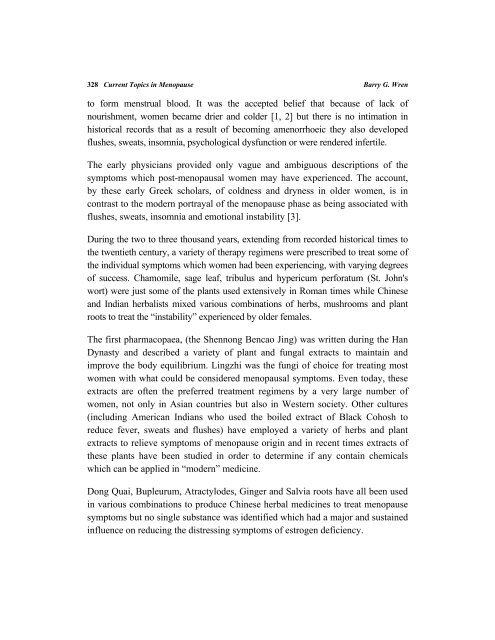Download - Bentham Science
Download - Bentham Science
Download - Bentham Science
You also want an ePaper? Increase the reach of your titles
YUMPU automatically turns print PDFs into web optimized ePapers that Google loves.
328 Current Topics in Menopause Barry G. Wren<br />
to form menstrual blood. It was the accepted belief that because of lack of<br />
nourishment, women became drier and colder [1, 2] but there is no intimation in<br />
historical records that as a result of becoming amenorrhoeic they also developed<br />
flushes, sweats, insomnia, psychological dysfunction or were rendered infertile.<br />
The early physicians provided only vague and ambiguous descriptions of the<br />
symptoms which post-menopausal women may have experienced. The account,<br />
by these early Greek scholars, of coldness and dryness in older women, is in<br />
contrast to the modern portrayal of the menopause phase as being associated with<br />
flushes, sweats, insomnia and emotional instability [3].<br />
During the two to three thousand years, extending from recorded historical times to<br />
the twentieth century, a variety of therapy regimens were prescribed to treat some of<br />
the individual symptoms which women had been experiencing, with varying degrees<br />
of success. Chamomile, sage leaf, tribulus and hypericum perforatum (St. John's<br />
wort) were just some of the plants used extensively in Roman times while Chinese<br />
and Indian herbalists mixed various combinations of herbs, mushrooms and plant<br />
roots to treat the “instability” experienced by older females.<br />
The first pharmacopaea, (the Shennong Bencao Jing) was written during the Han<br />
Dynasty and described a variety of plant and fungal extracts to maintain and<br />
improve the body equilibrium. Lingzhi was the fungi of choice for treating most<br />
women with what could be considered menopausal symptoms. Even today, these<br />
extracts are often the preferred treatment regimens by a very large number of<br />
women, not only in Asian countries but also in Western society. Other cultures<br />
(including American Indians who used the boiled extract of Black Cohosh to<br />
reduce fever, sweats and flushes) have employed a variety of herbs and plant<br />
extracts to relieve symptoms of menopause origin and in recent times extracts of<br />
these plants have been studied in order to determine if any contain chemicals<br />
which can be applied in “modern” medicine.<br />
Dong Quai, Bupleurum, Atractylodes, Ginger and Salvia roots have all been used<br />
in various combinations to produce Chinese herbal medicines to treat menopause<br />
symptoms but no single substance was identified which had a major and sustained<br />
influence on reducing the distressing symptoms of estrogen deficiency.
















